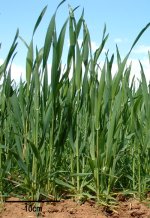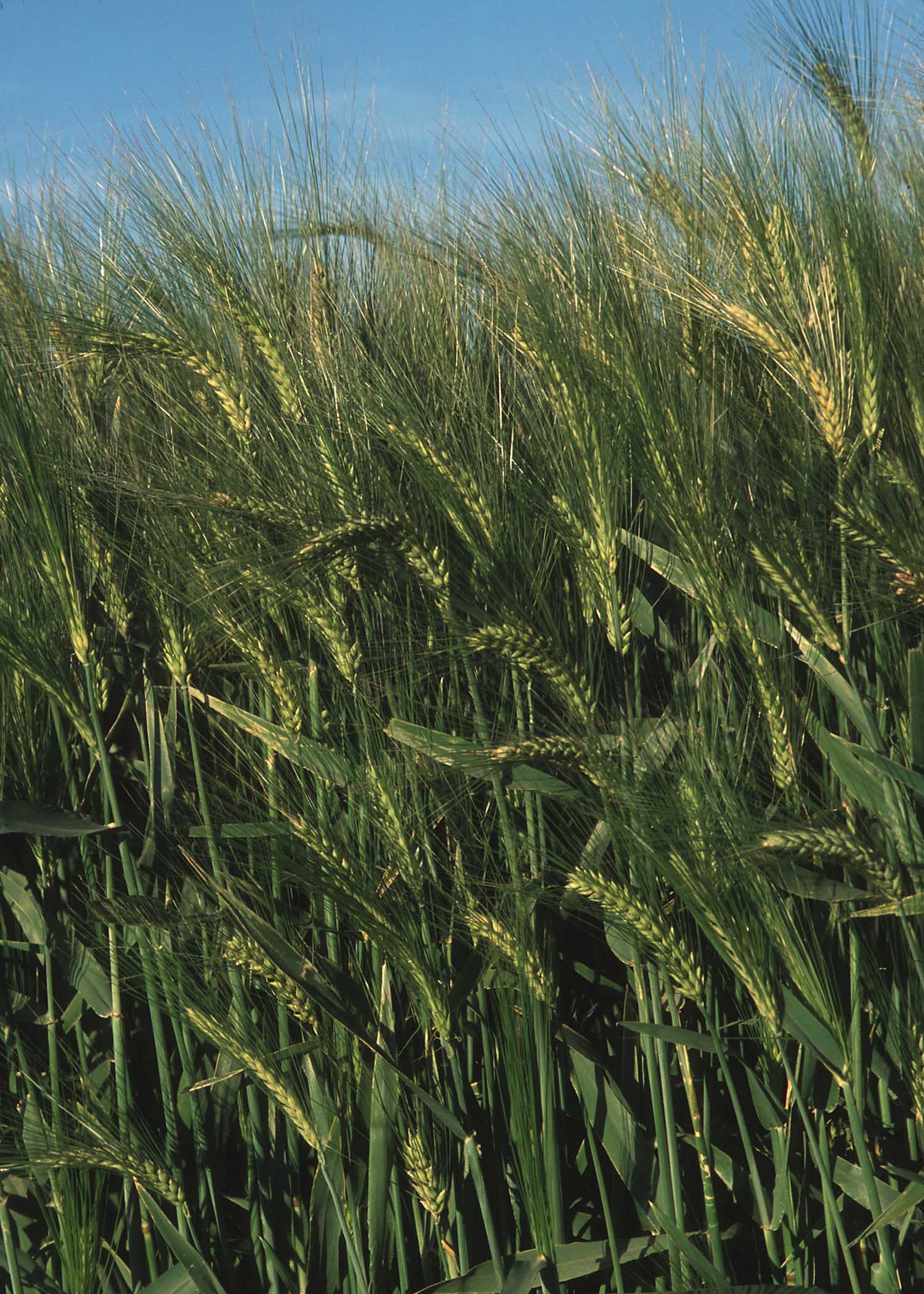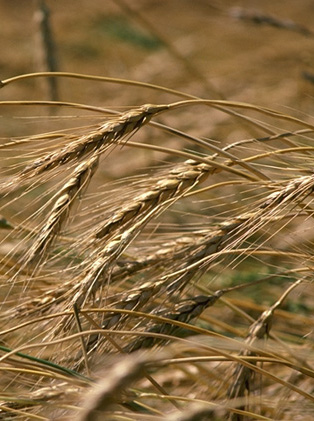![]() Species |
Rice |
Maize |
Wheat |
Barley |
Oats |
Foxtail Millet |
Pearl Millet |
Rye |
Sorghum |
Wild Rice |
Brachypodium |
Oryza Species |
Grape |
Arabidopsis
Species |
Rice |
Maize |
Wheat |
Barley |
Oats |
Foxtail Millet |
Pearl Millet |
Rye |
Sorghum |
Wild Rice |
Brachypodium |
Oryza Species |
Grape |
Arabidopsis
 |
 |
 |
 |
 |
| Leaf 1 emerges at soil level. Photo courtesy of: Wheat:The Big Picture | Young wheat. Photo courtesy of: Wheat:The Big Picture | Wheat starting to turn Photo courtesy USDA Photo by: Jeff Vanuga | Close up ripe wheat in Minnesota Image courtesy USDA, Photo by unknown | Harvested wheat Image courtesy USDA Photo by: Gene Alexander |
Grown all over the world, wheat covers more of the earth's surface than any other cereal crop (1, 7, 16). However, although it takes more land space than other cereals, based on a three year average it is only the third-largest cereal crop, behind maize and rice (16). The domestication of grains and the development of agricultural lifestyles led to significant changes in people's lives, encouraging permanent settlements, the development of civilization, and trade (7, 8). Wheat's domestication produced larger grains and a more productive crop, which could not have survived in the wild and required continued intervention of farmers intentionally planting it.
As one of the first grains to be domesticated, modern wheats developed from cultivation starting in the middle east about 9-11,000 years ago in the fertile crescent of the middle east (1, 6, 7, 8, 11, 12). Without a clearly identifiable timeframe, the Neolithic period is identified by the domestication of crops and animals (1, 12), which began with the development of farming, and endured until the development of metal tools.
By 4,000 BC the expanding geographical range of farming resulted in bread wheat becoming a common staple from England to China (1, 11). Although rice was more important to the development of East Asian cultures, wheat was the nutritional foundation for cultures in Europe, the middle east and western Asia (8, 11, 12).
Wheat was introduced in Mexico by the Spaniards around 1520, and to early American colonists in the 1600's (6, 12). At that time it was not popular in New England due to the soils and climate (11), but in the mid 1800's wheat was grown from seeds introduced by migrating Europeans and agricultural scientists in the area that would later be called the "Wheat Belt." (6, 11)
The 1830's saw the development of the reaping and threshing machines, allowing farmers to greatly increase their productivity during harvest (7, 11). The development of the steam engine in the 1880's and the internal combustion engine in the 1920's increased farmer productivity during both planting and harvest, and as a result wheat fields became larger (7).
Wheat is generally grown intended for food for humans, but lesser quality wheat and the nutrient-dense by-products of flour refining are used for animal feed. Wheat is also used for whiskey and beer production, and the husk can be separated and ground into bran (1, 6). Before the introduction of corn into Europe, wheat was the principal source of starch for sizing paper and cloth (5, 12).
Most breads, even rye and oat breads, are made with at least a portion of wheat flour because of two main quality characteristics of wheat that improve the breads - its gluten, and its alpha-amylase activity (1, 9). High gluten flours offer elasticity in the dough, allowing for it to rise without developing large air pockets. Tender pastries, like pie crusts and biscuits, are best with low gluten flours. All wheat flours are best with low alpha-amylase activity, because alpha amylase turns starch to sugar and prevents development of proper dough characteristics. Many flours are carefully blended mixtures of both hard and soft wheats designed precisely for a specific purpose (9).
Wheat cultivars can be classified by planting season, hardness of the grain, and (less importantly) color (1, 6, 9, 11, 17). Winter wheats are winter hardy, so they are planted in the fall. In the spring they resume maturation and are harvested early in the summer (6, 12). Spring wheats are planted in the spring and harvested late in the summer (6). Spring wheat yields are significantly lower than winter wheat yields, but it offers a very high quality for bread making (9).
Soft wheat varieties have starchy kernels (less gluten) which mill easier than the hard wheats. Soft wheat flour is preferred for piecrust, french bread, biscuits, and breakfast foods (1, 9, 12). Hard wheats have higher protein and gluten levels than their softer cousins, and are used for bread, cakes and flour (1, 9, 12). The hardest wheat is durum (T. durum), whose flour is used in the manufacture of macaroni, spaghetti, and other pasta products (12). Soft wheats and white wheats usually bring higher prices because they are easier to mill and don't require bleaching (1, 6).
The six major classes of wheat are listed below.
Hard red winter wheat is a high protein wheat used mostly for breads and all-purpose flour (1, 5, 6), and as an adjunct in other flours to increase protein content (1, 17). This class of wheat accounts for more than 40% of the U.S. wheat crop and half of U.S. wheat exports (5).
Durum wheat is a spring wheat, and may be either white or red. It is the hardest of all U.S. wheats, offers both high protein and high gluten content, and used to make the semolina flour used for premium pasta products and some Mediterranean breads (1, 5, 6, 17).
Hard red spring wheat is the highest protein wheat, and is used for bread, hard baked goods, all-purpose flour, and flour blends (1, 5, 6, 17).
Hard white wheat is medium protein grain that is closely related to red wheat except for color, in milling and baking qualities. However, it offers a milder, sweeter flavor, and is used in yeast breads, hard rolls, bulgur, tortillas, oriental noodles, whole wheat and all-purpose flowers, and used in brewing (1, 5, 17). It is the newest class of wheat to be grown in the United States (5, 17).
Soft red winter wheat has a low to medium protein content, and is used for breads and blending. (1, 5, 17) It is used to make cookies, cakes, donuts, and other fine pastries as well as flat breads, and crackers. (5, 6)Soft white wheat is a low protein wheat, but offers high yields to growers. It provides a whiter product for high quality cakes, crackers, cookies, pastries, and Asian-style noodles (bakery products other than breads), and is ideally suited to Middle Eastern flatbreads (1, 5, 6, 17).
References: